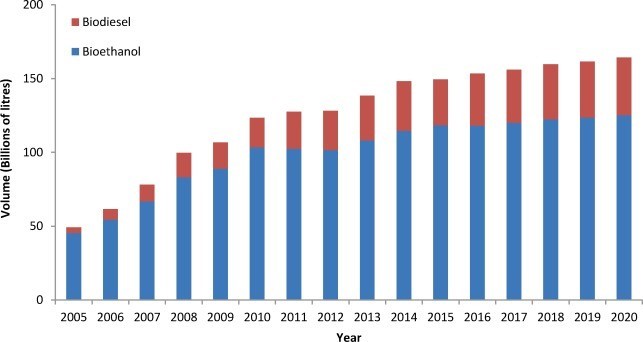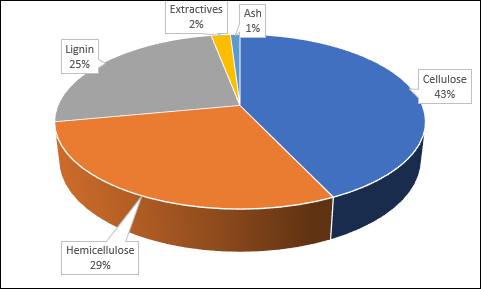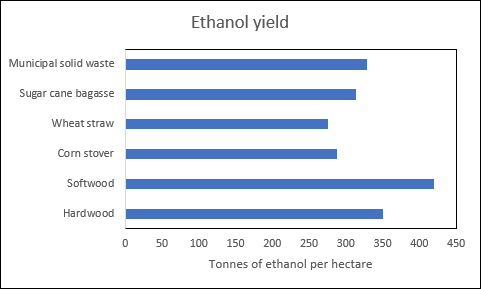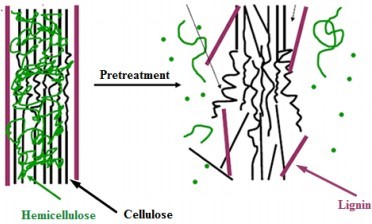Author

Second Generation Bioethanol – An Overview
Abbreviations
GHG | = | Greenhouse Gas |
iLUC | = | Indirect Land Use Change |
LCA | = | Life Cycle Assessment |
LUC | = | Land Use Change |
1 Abstract
Bioethanol is an effective alternative to fossil fuels, as it is a renewable energy source which also has the advantage of leading to a reduction in greenhouse gas emissions. The use of first generation bioethanol, however, leads to competition between land use for food and energy production purposes. Second generation bioethanol is an attractive option, as it eliminates the issue, while also permitting the use of waste as biomass. However, the process necessitates an expensive additional pretreatment step to work and the technology has not yet reached a technological readiness level which would allow it to be used on a large scale.
2 Introduction
Petroleum and other liquid fuels are the main source of energy in the global transportation sector (EIA 2017). As a consequence of the use of fossil fuels, the transportation sector is a large contributor to the emission of greenhouse gases (GHG), producing about 15% of the total emissions (Van Fan et al. 2018, Sharma et al. 2020). Therefore, there is an ongoing push to reduce the use of fossil fuels, both because of the aforementioned GHG emissions derived from their usage and because they are not renewable, thus making the current reliance on them not sustainable in the long term (Dar et al. 2018, Rahman et al. 2018). As a consequence, alternative fuels have been and continue to be researched: in particular, clean energy production based on biomass is one of the ways in which the transportation sector can reduce its dependence on fossil fuels (Ayodele et al. 2020). Indeed, one of the main reasons for the attractiveness of biofuels is that they represent a CO2 neutral, renewable energy source (Badwal et al. 2015). Bioethanol is one of the available biofuel options.
Figure 1 shows the global production of biofuels in the years 2005 to 2020. Bioethanol appears to be the predominant type by a large margin; as of 2018, its production amounted to 110 billion litres worldwide and it is expected to increase to 140 billion litres by 2022 (Sharma et al. 2020). Indeed, bioethanol is the biofuel with the largest production capacity on a global level. It is also an effective alternative fuel for petrol engines, due to its octane number and heat of vaporization being higher than those of gasoline. It can be used as a fuel both in hydrous form or mixed with gasoline. In the latter case, the hydrocarbon oxidation is more effective due to the elevated oxygen content of ethanol, which leads to reduced GHG emissions. Moreover, when it comes to gasoline blends, it has the most advanced government policies (Maican et al. 2015, Badwal et al. 2015, Ayodele et al. 2020). The US and Brazil are the two largest producers of bioethanol, and have been for the last two decades, in large part due to their high production levels of some common feedstocks (namely corn and sugarcane respectively). In 2018, the ethanol production of the US and Brazil amounted to 56 and 28% of the global value, respectively (Badwal et al. 2015, Gupta & Verma 2015, Oliveira et al. 2016, Ayodele et al. 2020, Cooper et al. 2020, Sharma et al. 2020).
Ethanol is an organic compound; specifically, an alcohol. Bioethanol is produced through the aerobic or anaerobic fermentation of carbohydrates. It is carried out with the intervention of select microorganisms, namely yeast and bacteria. The former is often the preferred option, due to its high tolerance to inhibitory compounds and ethanol itself, as well as its production rates (Damay et al. 2018, Cooper et al. 2020). The most commonly used yeast is the Saccharomyces cerevisiae, while the most frequently used bacterial species is the Zymomonas mobilis (Zabed et al. 2017).
The biofuel can be differentiated in two categories, depending on the biomass used in the production process: first and second generation bioethanol. First generation bioethanol is normally obtained from sugar- or starch-based crops; sugarcane, sugar beet, barley, corn and sweet sorghum being the main examples. This process is relatively common and it has been developed and is being used at industrial scale (Damay et al. 2018, Ayodele et al. 2020). The main issue with this process is that it leads to a competition between food and fuel when it comes to choosing how to use crops and arable land (Badwal et al. 2015, Damay et al. 2018, Marzo et al. 2019, Ayodele et al. 2020, Sharma et al. 2020). As of 2020, food-grade crops used as energy crops amounted to more than 96% of the global biofuel production. However, this situation is not sustainable in the long term; therefore, alternative solutions need to be found which can at least mitigate the problem (Sharma et al. 2020). Second generation bioethanol relies on the use of lignocellulosic material as biomass. Examples are agriculture residues, dedicated energy crops such as switchgrass and woody materials (Esmaeili et al. 2020). They are considered as a promising substitute, as they are available in large amounts, renewable and relatively inexpensive. However, there are issues with the use of these materials which have so far stopped the technology from being used on large scale. Currently, second generation bioethanol represents only 3% of the worldwide bioethanol production (Sharma et al. 2020).

Figure 1: Global biofuel production in the years 2005-2020 (OECD-FAO, 2018).
The goal of this paper is to analyse the bioethanol production process and highlight challenges and environmental advantages of using second generation bioethanol.
3 Discussion
Bioethanol can be produced from three types of feedstock: sugar, starch and lignocellulose. When it comes to simple sugars, water can be used to extract them from the crops used as biomass; these sugar molecules will then be fermented to obtain first generation bioethanol. Lignocellulose on the other hand has to be converted into sugars, normally by way of enzymatic hydrolysis, before they can be used to produce second-generation bioethanol. Therefore, the production process tends to be easier and less expensive for first generation bioethanol, due to the different composition of the selected biomass (Damay et al. 2018, Marzo et al. 2019, Ayodele et al. 2020).
3.1 Second generation bioethanol – Biomass
Bioethanol is produced from carbohydrates, i.e. biomolecules containing oxygen, hydrogen and carbon, the main example being glucose. These compounds are more easily accessible in first generation biomass. As mentioned above, however, second generation bioethanol is generally derived from lignocellulosic biomass. The average composition of this type of material is shown in Figure 2. However, different types of lignocellulosic material have slightly different composition, so the choice of one over another can have an impact on the ethanol yield; Table 1 shows the composition of several different biomass types, while Figure 3 shows the yield of second generation bioethanol obtained by using several different types of biomass.

Figure 2: Typical composition of lignocellulosic material. Data obtained from Latif et al. (2018).
Table 1: Composition of several biomass materials (Zhang 2020).
Biomass | Cellulose (%) | Hemicellulose (%) | Lignin (%) |
Corn stover | 37.5 | 30 | 10.3 |
Sugarcane bagasse | 45 | 20 | 30 |
Grasses | 25-40 | 35-50 | 10-30 |
Black locus (hardwood) | 41.6 | 17.7 | 26.7 |
Hybrid poplar (hardwood) | 44.7 | 18.6 | 26.4 |
Eucalyptus (hardwood) | 49.5 | 13.1 | 27.7 |
Hardwood stems | 40-55 | 24-40 | 18-25 |
Newspaper | 40-55 | 24-40 | 18-25 |

Figure 3: Yield of second generation bioethanol produced from different biomass materials. Data obtained from Gupta & Verma (2015).
Cellulose is the main component of lignocellulosic material and it is constituted of glucose monomers, connected in a strong crystalline structure insoluble in many organic solvents as well as in water. For the structure to dissolve in water, high temperature and pressure are needed (320 ◦C and 25 MPa respectively). The second-largest component, hemicellulose, is located in the secondary cell walls. It is a branched polymer, characterised by an amorphous structure containing hexoses and pentoses. Its lack of a crystalline structure makes it easier to hydrolise than cellulose. The third-largest component, lignin, is a biopolymer characterised by a highly disordered structure. It confers strength to the cell walls and it is not soluble in either alcohol or water. It is difficult to biodegrade and it is therefore an obstacle in the production of ethanol.
3.2 Pretreatment
Pretreatment is a necessary step to produce ethanol from lignocellulosic material, as without it, lignin prevents the enzymes involved in the reaction from reaching the cellulose and hemicellulose (Maican et al. 2015, Damay et al. 2018, Zhang 2020). Figure 4 shows the effect of a pretreatment step on the typical lignocellulosic material.

Figure 4: Effects of pretreatment on the components of lignocellulosic material (Maican et al. 2015).
The pretreatment step is the most expensive phase of the second generation bioethanol production; it is also often energy intensive. The goal is to extract monomeric carbohydrates from the biomass material; the process often involves several steps, including physical, chemical, thermal or enzymatic methods, or a combination of them. Enzymatic hydrolysis generally follows, due to its high levels of effectiveness. However, implementing it at the commercial level requires elevated capital costs. During this process, enzymes break down the cellulose and hemicellulose into monomeric sugars which will then be subjected to fermentation in order to obtain the final product. The pretreatment has to allow the enzymes to reach the molecules on which they can act (cellulose and hemicellulose), reduce the crystallinity of the cellulose structure and increase the porosity (and therefore the surface area) of aforementioned molecules. The formation of byproducts, as well as fermentation inhibitors such as phenolic compounds and weak acids, should also be checked during the pretreatment step. Moreover, different pretreatment methods may be preferable depending on the characteristics of the feedstock (mainly its lignin content). Furthermore, it should be considered that the type of pretreatment selected can impact both the way the hydrolysis and fermentation steps should be approached and the processing of any residues, from a technological perspective (Maican et al. 2015, Damay et al. 2018).
The pretreatment step is where most of the issues related to second generation bioethanol production are centered. It is the subject of ongoing research, aimed at finding a method which is both efficient and economically viable. Several options are being investigated at various scales. Currently, the main issues in need of being addressed are high costs, excessive use of land and water and elevated energy needs. Generally, the initial pretreatment step consists of mechanical grinding, so as to increase the specific area of the biomass and rendering the cellulose easier for the enzymes to reach. A thermochemical process is also needed to further promote hydrolysis; examples are acid pretreatment, steam explosion wet oxidation and CO2 explosion (Maican et al. 2015).
3.3 Using waste as substrate
Using waste rich in carbohydrates as a biomass for the production of ethanol is a particularly appealing prospect, as it would have the benefit of disposing of at least a fraction of the waste itself while also producing a fuel without the issue of the competition for arable land. Waste is a large category and numerous studies have been conducted using several different materials as biomass, from waste hamburgers to waste potatoes and more generally food waste; from waste paper to agricultural residues and forest-based woody waste. The results indicate that it is possible to produce ethanol from most types of sugar-rich or lignocellolusic materials, at least on a small scale (Gupta & Verma 2015, Memon et al. 2017, Ma et al. 2017, Santos et al. 2019, Han et al. 2020, Zhang 2020).
Converting food waste biomass into ethanol would be particularly useful, as it is readily available in large part of the world in considerable quantities. It has been found, however, that the hydrolysis process represents a bottleneck when it comes to food waste, controlling the fermentation efficiency. As a consequence, several methods have been studied to better understand this part of the production process; enzymatic hydrolysis has emerged as the preferable option over physical and chemical treatments, as it has a lower environmental impact. There is now a need for further research into producing suitable and inexpensive enzymes, so as to reduce costs and increase efficiency. Furthermore, at the current stage of development the process still produces significant quantities of solid residues rich in organic material, which then need to be disposed of (Ma et al. 2017). Agricultural residues represent another type of waste which is both inexpensive and available in large amounts. Indeed, cellulosic agricultural waste is the most abundant biomass on the planet: around 1.5×105 tons of lignocellulosic biomass is obtained annually from agricultural residues. Currently, large amounts of agricultural waste are disposed of every year: directing them towards ethanol production would allow them to be used for energy generation purposes (Gupta & Verma 2015). Table 2 shows the amount of biomass and the corresponding ethanol produced for different species of agricultural waste, while Table 3 shows the ethanol yield derived from several different types of fruit waste; the values are quite low, indicating limited efficiency.
Table 2: Worldwide biomass and bioethanol yield for different types of agricultural waste (Gupta & Verma 2015).
Wheat waste | Sugarcane waste | Rice waste | Barley waste | Corn waste | |
Biomass (Tg) | 382 | 187 | 758 | 64.5 | 230 |
Bioethanol yield (GL) | 119 | 55 | 223.5 | 22.5 | 22.5 |
Table 3: Ethanol yield obtained from different types of fruit waste Gupta & Verma (2015).
Fruit waste | Pineapple peel | Banana peel | Plantain peel | Apple pomace and rotten banana |
Ethanol yield (% v/v) | 8.34 | 7.45 | 3.98 | 38 |
3.4 Advantages and disadvantages of bioethanol production
It is difficult to estimate the effects of bioethanol production on the environment in anything other than a case-by-case situation, as they depend heavily on the type of feedstock and its availability, as well as the technology used for pretreatment and treatment. However, bioethanol offers the benefit of reduced GHG emissions; indeed, that is one of the driving forces behind the push to increase and improve its production. However, there is a risk that the emission saving derived from using biofuels rather than fossil fuels might be offset by the impact of the former in terms of land use change (LUC). Moreover, the formation and potential use of co-products, such as bioethanol residuals, needs to be accounted for in order for any estimates to be correct (Tonini et al. 2016). A well-to-wheel approach should be applied, in the context of an LCA study, to ensure that all parameters have been appropriately considered, before making a judgment on the potential emission savings brought about by the technology.
Early studies claimed that using biofuels to replace fossil fuels would lead to significant savings in terms of GHG emissions. These studies, however, failed to include the effects of indirect land use changes (iLUC); once those were considered, the results showed much more limited, if at all present, emission reductions. The impact of iLUC can be summarised as follows: using crops to meet energy as well as food demand leads to an increased need for crops, which in turns provokes an increase in the necessary arable land and higher productivity requirements. These developments generate significant CO2 emissions (Tonini et al. 2016). As an example, a case study in Thailand found that iLUC emissions related to molasses and cassava-bioethanol production were equivalent to about 39-76% of the emissions from gasoline, while another study showed that emissions savings from biofuel use in the EU amount to -2 to 13%, once LUC emissions are considered (Prapaspongsa & Gheewala 2016, Woltjer et al. 2017). These results show the importance of taking into account LUC and iLUC when estimating GHG emission savings; they also show how the impact of bioethanol production may differ depending on the circumstances, such as the biomass used and the chosen technology.
In general, second generation bioethanol has a higher GHG reduction potential than its first generation counterpart and LCA studies analysing the long-term effects of producing and using second generation bioethanol show that it will lead to lesser environmental impacts (Sharma et al. 2020). Moreover, iLUC have an impact in particular on first generation biofuel production, but their relevance is less significant where second generation bioethanol is concerned, as the chosen biomass in this case does not affect food production crops (Gerbrandt et al. 2016, Zhang 2020). Indeed, the great advantage of second generation bioethanol is that, if the process was implemented on large scale, it would virtually eliminate the issue of food versus energy competition, while also, at least in certain circumstances, allowing to generate energy from waste materials (Marzo et al. 2019).
While second generation bioethanol is the more convenient alternative where GHG emissions are concerned, the procedure has not yet been perfected. At present, the main issue is that the technological readiness level is not yet sufficient to apply the process on large scales; moreover, once the production methods are refined, they will still need to be adapted to each individual feedstock (Sharma et al. 2020).
There are several reasons why the production process has not yet been implemented on industrial scale. The most pressing issue is economical, as the necessary pretreatment of the biomass leads to significant expenses, constituting around 18% of the overall production costs (Rajendran et al. 2018, Marzo et al. 2019). Additionally, there is the necessity of dealing with spentwash, which is the liquid waste derived from the process. This issue is common to both first and second generation bioethanol production, and it constitutes a significant expense for manufacturers (Cooper et al. 2020). Another factor to be considered is the often limited ethanol yield. In recent years there have been significant technological developments aimed at solving this problem (i.e. at increasing the yield of ethanol per biomass unit), but there are additional costs to be considered (Zabed et al. 2017, Cooper et al. 2020). Future research should focus on containing production costs and improving the efficiency of the pretreatment step. Studies have also been conducted to establish the possibility of combining first and second generation ethanol production processes, so as to reduce GHG emissions and waste while maintaining elevated yields and containing the expenses (Oliveira et al. 2016, Ayodele et al. 2020).
This article only considered first and second generation bioethanol production. However, it should be mentioned that there are studies looking into third and fourth generation biofuel production as well. This research is still at the beginning stages, but it is promising. Third generation biofuel is generated from algal biomass (macro- and microalgae), while fourth generation biofuels derived from algae modified through genetic engineering, so as to increase the biofuel yield (Sharma et al. 2020).
4 Conclusions
While on the surface the concept of bioethanol is appealing from an environmental perspective, LCA studies have shown that the benefits at the end of the production process can be outweighed by increased emissions and at the beginning of that same process. This issue, however, is not particularly significant when it comes to second generation bioethanol. Exclusive reliance on first generation bioethanol is not sustainable in the long term, as it leads to land use competition between fuel and food production. Second generation bioethanol can contribute to the elimination of this problem, thus representing a valid and lasting alternative to fossil fuels. The possibility of using waste as biomass for the process further enhances its suitability, as it allows to generate energy from residues. However, the technology is not yet ready to be used on large scale and therefore further studies need to be carried out to improve its viability. One of the main issues complicating the expansion of this approach to ethanol production is the high costs, mainly related to the necessary pretreatment step.
The parameters to consider when analysing the viability of second generation bioethanol range from the purely economical to the environmental and societal. Overall, second generation bioethanol production has the potential to be truly useful, but more studies need to be conducted before that potential can become a practical reality.
References
Ayodele, B. V., Alsaffar, M. A. & Mustapa, S. I. (2020), ‘An overview of integration opportunities for sustainable bioethanol production from first-and second-generation sugar-based feedstocks’, Journal of Cleaner Production 245, 118857.
Badwal, S., Giddey, S., Kulkarni, A., Goel, J. & Basu, S. (2015), ‘Direct ethanol fuel cells for transport and stationary applications–a comprehensive review’, Applied Energy 145, 80– 103.
Cooper, J., Kavanagh, J., Razmjou, A., Chen, V. & Leslie, G. (2020), ‘Treatment and resource recovery options for first and second generation bioethanol spentwash–a review’, Chemosphere 241, 124975.
Damay, J., Boboescu, I.-Z., Duret, X., Lalonde, O. & Lavoie, J.-M. (2018), ‘A novel hybrid first and second generation hemicellulosic bioethanol production process through steam treatment of dried sorghum biomass’, Bioresource technology 263, 103–111.
Dar, R. A., Dar, E. A., Kaur, A. & Phutela, U. G. (2018), ‘Sweet sorghum-a promising alternative feedstock for biofuel production’, Renewable and Sustainable Energy Reviews 82, 4070–4090.
EIA, G.T.E., 2017. Examination of Scenarios to 2040 using ITEDD. US Department of Energy, Washington.
Esmaeili, S. A. H., Szmerekovsky, J., Sobhani, A., Dybing, A. & Peterson, T. O. (2020), ‘Sustainable biomass supply chain network design with biomass switching incentives for first-generation bioethanol producers’, Energy Policy p. 111222.
Gerbrandt, K., Chu, P. L., Simmonds, A., Mullins, K. A., MacLean, H. L., Griffin, W. M. & Saville, B. A. (2016), ‘Life cycle assessment of lignocellulosic ethanol: a review of key factors and methods affecting calculated ghg emissions and energy use’, Current opinion in biotechnology 38, 63–70.
Gupta, A. & Verma, J. P. (2015), ‘Sustainable bio-ethanol production from agro-residues: a review’, Renewable and sustainable energy reviews 41, 550–567.
Han, W., Liu, Y., Xu, X., Huang, J., He, H., Chen, L., Qiu, S., Tang, J. & Hou, P. (2020), ‘Bioethanol production from waste hamburger by enzymatic hydrolysis and fermentation’, Journal of Cleaner Production p. 121658.
Latif, A., Harun, S., Sajab, M. S., Markom, M. & Jahim, J. (2018), ‘Ammonia-based pre- treatment for ligno-cellulosic biomass conversion an overview’, Journal of Engineering Science and Technology 13, 1595–1620.
Ma, Y., Cai, W. & Liu, Y. (2017), ‘An integrated engineering system for maximizing bioenergy production from food waste’, Applied Energy 206, 83–89.
Maican, E., Coz, A. & Ferde¸s, M. (2015), Continuous pretreatment process for bioethanol production, in ‘4th International Conference on Thermal Equipment, Renewable Energy and Rural Development. Romania’, Vol. 35, p. 287.
Marzo, C., D´ıaz, A. B., Caro, I. & Blandino, A. (2019), Status and perspectives in bioethanol production from sugar beet, in ‘Bioethanol Production from Food Crops’, Elsevier, pp. 61– 79.
Memon, A., Shah, F. & Kumar, N. (2017), Bioethanol production from waste potatoes as a sustainable waste-to-energy resource via enzymatic hydrolysis, in ‘IOP Conference Series: Earth and Environmental Science’.
Oliveira, C., Cruz, A. & Costa, C. (2016), ‘Improving second generation bioethanol produc- tion in sugarcane biorefineries through energy integration’, Applied Thermal Engineering 109, 819–827.
Organisation for Economic Co-operation and Development, 2018. OECD-FAO agricultural outlook 2018-2027. OECD Publishing.
Prapaspongsa, T. & Gheewala, S. H. (2016), ‘Risks of indirect land use impacts and green- house gas consequences: an assessment of thailand’s bioethanol policy’, Journal of Cleaner Production 134, 563–573.
Rahman, S. S., Hossain, M. M., Choudhury, N. et al. (2018), ‘Bioethanol fermentation from kitchen waste using saccharomyces cerevisiae’, F1000Research 7(512), 512.
Rajendran, K., Drielak, E., Varma, V. S., Muthusamy, S. & Kumar, G. (2018), ‘Updates on the pretreatment of lignocellulosic feedstocks for bioenergy production–a review’, Biomass conversion and biorefinery 8(2), 471–483.
Santos, C., Brito, P., Santos, A., Pantoja, L., Costa, A. & Santos, A. (2019), ‘Production of lignocellulosic ethanol from waste paper: review on production technology’, International Journal of Development Research 9, 28383–28390.
Sharma, B., Larroche, C. & Dussap, C.-G. (2020), ‘Comprehensive assessment of 2g bioethanol production’, Bioresource Technology p. 123630.
Tonini, D., Hamelin, L., Alvarado-Morales, M. & Astrup, T. F. (2016), ‘Ghg emission factors for bioelectricity, biomethane, and bioethanol quantified for 24 biomass substrates with consequential life-cycle assessment’, Bioresource Technology 208, 123–133.
Van Fan, Y., Perry, S., Klemeˇs, J. J. & Lee, C. T. (2018), ‘A review on air emissions assessment: Transportation’, Journal of cleaner production 194, 673–684.
Woltjer, G., Daioglou, V., Elbersen, B., Iban˜ez, G. B., Smeets, E., Gonz´alez, D. S. & Barn´o, G. (2017), Study report on reporting requirements on biofuels and bioliquids stemming from the directive (EU) 2015/1513, EU Commission.
Zabed, H., Sahu, J., Suely, A., Boyce, A. & Faruq, G. (2017), ‘Bioethanol production from renewable sources: Current perspectives and technological progress’, Renewable and Sus- tainable Energy Reviews 71, 475–501.
Zhang, C. (2020), ‘Lignocellulosic ethanol: Technology and economics’, Alcohol fuels-current technologies and future prospect pp. 1–21.